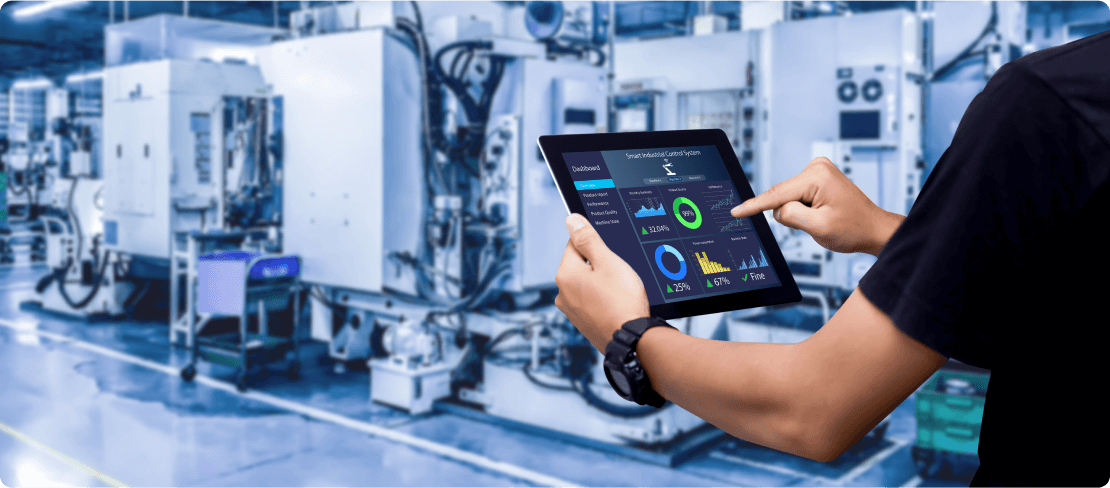
Introduction
Digital Twins are virtual replicas of physical objects, systems, processes, and assets that use real-time historical data insights from AI/ML development services to provide meaningful metrics to manufacturers and help them drive improved decisions. The critical components of Digital Twins include Industry 5.0 and the Industrial Internet of Things (IIoT). The four types of Digital Twins used in manufacturing are Asset or Product Twins, Process Twins, System or Unit Twins, and Component or Part Twins.
Actors
01
Manufacturing Company/Operator
The manufacturing firm producing items, and the operator oversees and manages the end-to-end production process.
02
Data Engineer/ Analyst
Responsible for understanding and analyzing data gathered from multiple sources, such as Digital Twin assets and AI/ML models, to derive valuable insights for making informed decisions.
03
Maintenance Technicians
They maintain, upgrade, and service the manufacturing software development and equipment.
Preconditions
Developing the Digital Twin
The manufacturing unit has set the Digital Twin to carry out the production process and sync it with real-time gathered from IoT sensors.
IoT Sensor Infrastructure
The manufacturing equipment and devices have an IoT development-based sensor network, capturing real-time data from machines and production stages. The data includes vital insights about the device’s pressure, temperature, vibration, and more.
Creating the AI/ML Model
The manufacturing plant can leverage the trained and advanced AI/ML models to analyze data from the Digital Twin to identify patterns, correlations, and anomalies and make predictions.
Post Conditions
Enhanced Production Efficiency
Digital Twin in manufacturing combines AI/ML development services and advanced technology to accelerate, improve production efficiency, and optimize the entire process.
Minimize Downtime
With Artificial Intelligence and Machine Learning, Digital Twin enables manufacturers to reduce downtime and unseen equipment failures.
Manufacturing High-Quality Products
Integrating AI/ML Development Services with a Digital Twin in Manufacturing. It helps them implement and maintain industry quality standards, mitigate defects, and reduce waste, enhancing customer satisfaction.
Leverage Real-Time Data Insights
AI/ML models and Digital Twins offer real-time valuable data insights for informed decision-making. Furthermore, data analysts can make viable choices about quality adjustments and maintenance actions.
Supply Chain Optimization
Manufacturing firms can use Digital Twin in manufacturing and AI/ML development services to track and analyze packaging, fleet, and route management. It helps to optimize the supply chain and logistics process.
Main Flow
Alternative Flow
- Maintaining the Equipment/Assets Manually - In a typical scenario, maintenance operations receive instant alerts on downtime. But in exceptional cases, Digital Twins, AI, and ML may fail to send predictive maintenance alerts. Technicians must manually carry out emergency maintenance tasks, impacting all production efficiency.
- Improper Collaboration or Miscommunication -Communication between the maintenance operator and data analysts regarding ignorance of process optimization can lead to production and overall operations inefficiencies. Coming to a unanimous decision may become a time-consuming process.
- Producing Substandard Quality Products - There may be exceptions where the maintenance operator neglects or dismisses quality alerts, leading to manufacturing substandard products and customer dissatisfaction. High-end quality assurance parameters are reinforced, preventing such occurrences.

Conclusion
In alignment with Artificial Intelligence and Machine Learning, Digital Twin in manufacturing software development allows manufacturers to boost production efficiency, improve product quality, and bring cost efficiency. All these transformative technologies emphasize enhancing predictive maintenance, quality assurance, and process optimization, leading to overall amplified performance.
Suggested TechStack
IoT sensors help Digital Twins leverage continuous real-time data to enhance team communication. They collect data from equipment to create a Digital Twin and monitor predictive maintenance.

The engineering team may require CAD or 3D software tools to design the layout of a new product. They may combine these CAD systems with Digital Twins to make seamless changes in the product design.

Cloud engineering services help to host Digital Twin components by providing scalable resources, and serverless computing is used for demand-based scaling and event-driven processing.

Enables the manufacturing company to efficiently and securely manage all created and gathered data. It can work file changes over time and store modifications in the database.

Explore the Intersection of Digital Twins, AI, and ML for Enhanced Productivity
Ready to Transform Your Manufacturing

